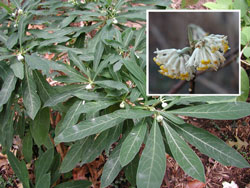Resource Library
Plant of the Week: Paperbush
The University of Arkansas System Division of Agriculture does not promote, support or recommend plants featured in "Plant of the Week." Please consult your local Extension office for plants suitable for your region.
Plant of the Week
Paperbush
Latin: Edgeworthia chrysantha

Though we are firmly into winter, it is easy for a gardener to think of spring. One of the newly planted shrubs in my shade garden - an Edgeworthia chrysantha - should be among the first plants to report the arrival of spring. I expect blooms in early March.
Edgeworthia, also called paperbush, is a mounded, low-branched deciduous shrub of the daphne family that grows 3- to 4-feet tall and as much as 4- to 6-feet across. It has stout branches that give the shrub an open, barren look in the winter.
Each of the stubby terminal branches may contain a swollen, silvery bud that will produce a cluster of fuzzy, slightly fragrant trumpet shaped flowers in late winter or early spring. The fuzzy white, changing-to -yellow, flowers produce a half-inch long trumpet with four spreading petals at the end. As many as 35 flowers may be produced in each inflorescence. The flowers are admittedly more interesting than beautiful, but that early in the season there isn’t much competition, so they are much appreciated.
As the flowers begin to fade, the new 5-inch long, blue-green leaves form at the ends of the branches in neat whorls. The summertime appearance is that of a tidy mounded shrub.
Edgeworthia is native to China from where it was introduced in 1845 by Robert Fortune, the plant explorer sent out from London by the Royal Horticultural Society at the close of the first Opium War. It is named for Michael P. Edgeworth (1812-1881), a long-time employee of the East India Company, who traveled throughout India collecting plants and recording information about the antiquities and linguistics of the country during the height of British colonization.
Paperplant is the common name used for this plant. In the 13th century, Marco Polo reports the use of paper currency and seems amazed at by it. Dan Hinkley, a modern-day plant explorer from the Pacific Northwest, tells of seeing Edgeworthia being grown in 2004 under cultivation for production of high-quality paper. Botanists in the "Flora of China" report that this plant has a high content of tough fibers that make it ideal for use in high-quality printing such as paper currency. The thought that Marco Polo may have handled currency made from an ancestor of the Edgeworthia growing in my garden is an intriguing thought.
Edgeworthia grows throughout a wide swath of southern China and into adjacent countries of south Asia. It is typically found on sloping, moist, but well-drained sites, that tend toward cool, but not cold. It is hardy from zone 7 to 9 but may be planted a bit further north or south if well sited. It is best in an area such as where a hydrangea would grow: Uniformly moist soil with bright light but shaded during the heat of the day.
According to the "Flora of China,"the only deciduous Edgeworthia is E. chrysantha. The name E. papyrifera is a synonym that is rejected because it showed up in print a few months later than the accepted E. chrysantha. In plant naming, getting there first is critical. The clone listed as ‘Red Dragon’ is a selection of the evergreen species E. gardenii.
By: Gerald Klingaman, retired
Extension Horticulturist - Ornamentals
Extension News - January 15, 2010
The University of Arkansas System Division of Agriculture does not maintain lists of retail outlets where these plants can be purchased. Please check your local nursery or other retail outlets to ask about the availability of these plants for your growing area.